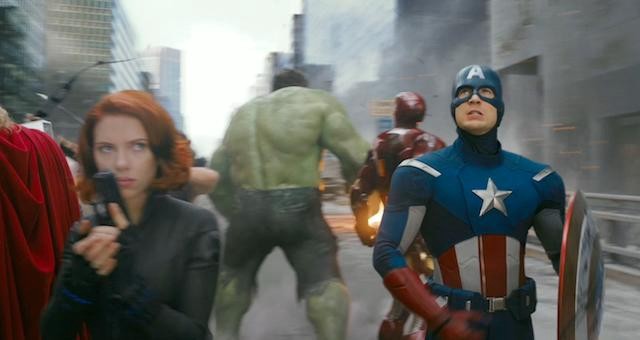Retailers Bending Gender for Profit, Still Lag Miserably Behind Comic Books
by Natasha Gural

It’s 2015, and toymakers are finally re-evaluating how they market some items only to one gender. Big box chains are also beginning to dabble in gender-neutral or androgynous labels and departments.
Let’s stop pretending that retailers are blazing new trails. This push to amp up sales of the $22 billion toy industry is barely catching up to decades-old cultural outings originating in the comic book world.
I cheered loudest for a girl I don’t know marching in my son’s elementary school Halloween parade dressed as the Black Widow. She smiled when I called out “Natasha Romanoff! Yay!” Most parents seemed to have no idea who she was, even with Scarlett Johansson slinking into the adult costume for the Iron Man franchise.
I’d have applauded just as aggressively for a little girl throwing her mighty shield, but there wasn’t a female Captain America in the procession. (Though one of my 5½-year-old son’s best girl friends was a Shock Trooper, a costume very clearly marketed to boys, at least based on a Google search.)
Even I know that Secret Wars 2099 features a female Captain America. Comic books have always transcended normative gender roles.
As my husband and son have taught me, Marvel’s female versions of heroes include Aberration and Abominatrix (Abomination), Aftershock (Electro), Agony and Ann Weying (Venom), Alkhema (Ultron), American Dream (Captain America), Ana Kravinoff (Kraven the Hunter), Arachnophilia and Ashley Barton (Spider-Man), Ardina (Silver Surfer), Astrid Mordo (Baron Karl Amadeus Mordo), and Axon (ZZax). And that’s just some of the As.
A female God(dess) of Thunder is as real in the Marvel Universe as Australian TV hunk-turned Hollywood heartthrob Chris Hemsworth wielding Mjolnir (the hammer) on the big screen. The behemoth studios, though, are far from elevating any women heroes to the status they’ve long commanded in comic books.
Viz: “Whosoever holds this hammer, if SHE be worthy, shall possess the power of Thor.”
Stan Lee and Jack Kirby have been creating strong female heroes with powers to rival, even overtake, their male counterparts for decades. The “new” Thor unveiled this spring is a reimaging of longtime Thor supporting character Jane Foster, who first materialized in graphic form in 1962, as the paramour to Dr. Donald Blake (Thor’s alter ego).
Jane (now just Thor) had been peppered through the pages of Marvel comic books since the 1970s, and even was promoted from nurse to doctor. Jane’s Hollywood debut as Thor’s astrophysicist lover portrayed by Natalie Portman is hardly a groundbreaking feminist victory.
Neil Gaimain’s character Desire in “The Sandman” echoes 1970s androgyny reminiscent of David Bowie, or as Gaiman puts it, “Desire cares more for what lurks beneath the skin than what is formed in the flesh.” But don’t expect Disney to buy the rights and cast Rain Dove, who catwalked New York’s Fashion Week in both menswear and womenswear, as Desire. Trust I’ve seen no children donning that costume, and I don’t think you’ll find it nearly pre-packaged for sale.
High fashion prevails in a GLBT-friendly world patronized by the 1%, who can pay full retail, even for couture, and its hangers-on, who may have to beg, borrow or steal for the look of the moment. While fast fashion chains like H&M and Uniqlo are quick to copy haute trends, the mass market may not be ready for a kid-friendly version of androgyny-fits-all.
As Black Friday approaches, the multi-billion-dollar toy industry has to make tough decisions. Ahead of the (long overdue) curve, Target in August ditched signs to label toys for girls and boys. The Disney Store (which, as my husband laments “stole my childhood” by swallowing both Marvel and Star Wars) wisely did away with girl and boy labels for children’s Halloween costumes, and is de-gendering promotion of lunchboxes and backpacks.
I’m not begrudging the shift in retail marketing, I’m only saying it’s too little too late, and only in an effort to shore up sales. It’s not giving props to the real game-changers and just how far we’ve crept since the 1960s before trying to bounce back, in a ever-so-cushioned way.
In the 1960s, super-powered women such as Susan Storm (then The Invisible Girl), The Wasp, The Scarlet Witch, and Jean Grey were mighty members of the Fantastic Four, the Avengers, and the X-Men.
In the 1970s, The Black Widow broke out her now iconic ebony costume, mainstreamed only now by Johansson, in Amazing Spider-Man #86, before taking the lead in Amazing Adventures, a title she shared with the Inhumans (now resurrected commercially by “Agents Of S.H.I.E.L.D.”) for eight issues.
In the 1980s, She-Hulk joined the Avengers, as well as the Fantastic Four, where she replaced The Thing.
Maybe Halloween 2016 will bring out a gender-neutral or androgynous Dazzler. A recovering 1980s teenage shopgirl can dream.
Support The Billfold
The Billfold continues to exist thanks to support from our readers. Help us continue to do our work by making a monthly pledge on Patreon or a one-time-only contribution through PayPal.
Comments